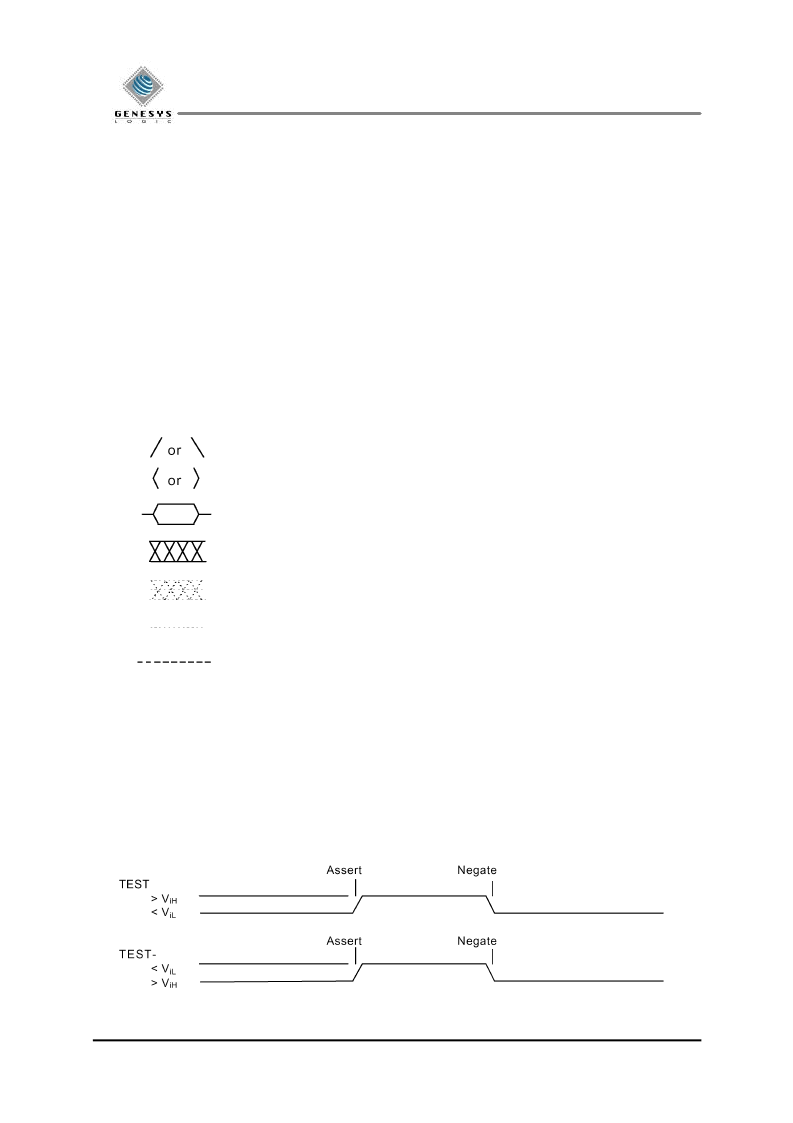- 您現(xiàn)在的位置:買(mǎi)賣(mài)IC網(wǎng) > PDF目錄383001 > GL811E (Electronic Theatre Controls, Inc.) USB 2.0 to ATA / ATAPI Bridge Controller PDF資料下載
參數(shù)資料
| 型號(hào): | GL811E |
| 廠商: | Electronic Theatre Controls, Inc. |
| 英文描述: | USB 2.0 to ATA / ATAPI Bridge Controller |
| 中文描述: | USB 2.0至的ATA / ATAPI控制器橋 |
| 文件頁(yè)數(shù): | 17/35頁(yè) |
| 文件大小: | 1290K |
| 代理商: | GL811E |
第1頁(yè)第2頁(yè)第3頁(yè)第4頁(yè)第5頁(yè)第6頁(yè)第7頁(yè)第8頁(yè)第9頁(yè)第10頁(yè)第11頁(yè)第12頁(yè)第13頁(yè)第14頁(yè)第15頁(yè)第16頁(yè)當(dāng)前第17頁(yè)第18頁(yè)第19頁(yè)第20頁(yè)第21頁(yè)第22頁(yè)第23頁(yè)第24頁(yè)第25頁(yè)第26頁(yè)第27頁(yè)第28頁(yè)第29頁(yè)第30頁(yè)第31頁(yè)第32頁(yè)第33頁(yè)第34頁(yè)第35頁(yè)

GL811E USB 2.0 to ATA/ATAPI Bridge Controller
2000-2004 Genesys Logic Inc. - All rights reserved.
Page 17
6.4 AC Characteristics- ATA/ ATAPI
The GL811E complies with ATA / ATAPI-6 specification rev 1.0, which supports following data transfer modes:
1.
DMA (Direct Memory Access) data transfer:
DMA data transfer means of data transfer between device and host memory without host processor
intervention.
-
Multiword DMA: Multiword DMA is a data transfer protocol used with the READ DMA, WRITE
DMA, READ DMA QUEUED, WRITE DMA QUEUED and PACKET commands. When a
Multiword DMA transfer is enabled as indicated by IDENTIFY DEVICE or IDENTIFY PACKET
DEVICE data, this data transfer protocol shall be used for the data transfers associated with these
commends. (Please refer to the ATA / ATAPI-6 specification rev 1.0 for more information.)
-
Ultra DMA: Ultra DMA Is a data transfer protocol used with the READ DMA, WRITE DMA,
READ DMA QUEUED, WRITE DMA QUEUED and PACKET commands. When this protocol is
enabled, the Ultra DMA protocol shall be used instead of the Multiword DMA protocol when these
commands are issued by the host. This protocol applies to the Ultra DMA data burst only. (Please
refer to the ATA / ATAPI-6 specification rev 1.0 for more information.)
Following listed the symbols and their respective definitions that are used in the timing diagram:
All signals are shown with the asserted condition facing to the top of the page. The negated condition is shown
towards the bottom of the page relative to the asserted condition.
The interface uses a mixture of negative and positive signals for control and data. The terms asserted and
negated are used for consistency and are independent of electrical characteristics.
In all timing diagrams, the lower line indicates negated, and the upper line indicates asserted. The following
illustrates the representation of a signal named Test going from negated to asserted and back to negated, based
on the polarity of the signal.
-
Signal transition (asserted or negated)
-
Data transition (asserted or negated)
-
Data valid
-
Undefined but not necessarily released
-
Asserted, negated or released
-
Released
-
The “other” condition if a signal is shown with no change
相關(guān)PDF資料 |
PDF描述 |
|---|---|
| GL813 | USB 2.0 CompactFlash Card Reader Controller |
| GL911Tx | Wireless Mouse Transmitter Controller |
| GLT41016 | 64K X 16 CMOS DYNAMIC RAM WITH EXTENDED DATA OUTPUT |
| GLT41016-30J4 | 64K X 16 CMOS DYNAMIC RAM WITH EXTENDED DATA OUTPUT |
| GLT41016-30TC | 64K X 16 CMOS DYNAMIC RAM WITH EXTENDED DATA OUTPUT |
相關(guān)代理商/技術(shù)參數(shù) |
參數(shù)描述 |
|---|---|
| GL811E-04G | 制造商:GENESYS-LOGIC 功能描述: |
| GL811E-MNGXX | 制造商:GENESYS 制造商全稱(chēng):GENESYS 功能描述:USB 2.0 to ATA / ATAPI Bridge Controller |
| GL811E-MNNXX | 制造商:GENESYS 制造商全稱(chēng):GENESYS 功能描述:USB 2.0 to ATA / ATAPI Bridge Controller |
| GL811E-MSGXX | 制造商:GENESYS 制造商全稱(chēng):GENESYS 功能描述:USB 2.0 to ATA / ATAPI Bridge Controller |
| GL811E-MSNXX | 制造商:GENESYS 制造商全稱(chēng):GENESYS 功能描述:USB 2.0 to ATA / ATAPI Bridge Controller |
發(fā)布緊急采購(gòu),3分鐘左右您將得到回復(fù)。